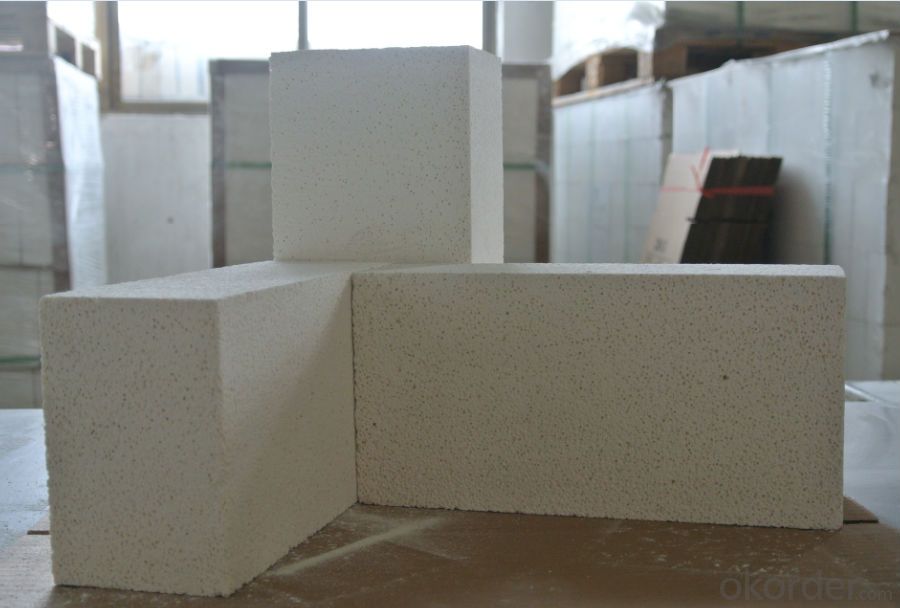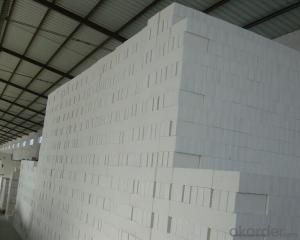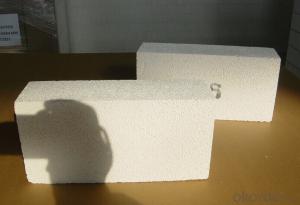Insulation Bricks Or Insulation Fire Brick High Quality GJM23 26
- Loading Port:
- Shanghai
- Payment Terms:
- TT OR LC
- Min Order Qty:
- 5000 pc
- Supply Capability:
- 50000 pc/month
OKorder Service Pledge
OKorder Financial Service
You Might Also Like
1.Description of Insulation Brick:
CMAX insulating firebricks are classified under temperature between 1100℃ to 1700℃, manufactured from high purity alumina clay..
2.Main features of Insulation Brick:
◆Light weight and low thermal conductivity ◆Low heat storage
◆Low iron and impurities ◆High thermal shock resistance
3. Insulation Brick Images:


4. Insulation Brick Technical Parameters
Our Insulation Brick contains 20, 23, 25,26, 28, 30, 32. Classification temperature is from 1100℃ to 1760℃. Density is from 0.52g/cm3 to 1.25g/cm3. As we all know, the company type is 23 and 26.
1) For the 23, its density is 0.52g/cm3, but some customer may require 0.8g/cm3, we can also meet your special require. Content of Al2O3 is about 45%.
2) For the 26, its density is 0.8g/cm3, but if you have other special requirement on that, pls also tell us. Content of Al2O3 is about 55%.
Application: CMAX insulating firebricks can be used as a hot face lining directly exposed to the heat or as a backup insulation layer in iron and steel mills, non-ferrous foundries, petrochemical, ceramic, glass. If you need other application picture, please contact with us
5.FAQ
We have organized several common questions for our clients,may help you sincerely:
① How about our Insulation Brick?
A world class manufacturer & supplier of InsulationBrick is one of the large scale professional investment casting production bases in China,consisting of both casting foundry forging and machining factory. Annually more than 8000 tons Precision casting and forging parts are exported to markets in Europe,America and Japan. OEM casting and forging service available according to customer’s requirement.
②How to guarantee the quality of the products?
We have established the international advanced quality management system every link from raw material to final product we have strict quality test; We resolutely put an end to unqualified products flowing into the market. At the same time, we will provide necessary follow-up service assurance.
- Q:Can insulating fire bricks be used for insulation in smelters?
- Indeed, insulation in smelters can be achieved by utilizing insulating fire bricks. These bricks are purposefully crafted to endure elevated temperatures and offer exceptional thermal insulation. Composed of lightweight refractory materials with low thermal conductivity, they effectively retain heat and limit heat dissipation. As a result, they prove to be a perfect choice for smelters, where maintaining optimal temperatures is imperative for efficient metal smelting operations. Furthermore, insulating fire bricks possess resistance against chemical corrosion and mechanical strain, guaranteeing their longevity and appropriateness for use in demanding smelting settings.
- Q:Can insulating fire bricks be used in hydrogen furnaces?
- Yes, insulating fire bricks can be used in hydrogen furnaces. These bricks are specifically designed to withstand high temperatures and provide excellent thermal insulation, making them suitable for use in hydrogen furnaces where extreme heat is involved.
- Q:Can insulating fire bricks be used in cryogenic applications?
- Insulating fire bricks, also known as refractory bricks, serve primarily for high-temperature purposes and find common usage in furnaces and kilns. Nonetheless, when it comes to cryogenic applications involving extremely low temperatures, insulating fire bricks may prove to be unsuitable. Cryogenic temperatures, usually below -150 degrees Celsius (-238 degrees Fahrenheit), present distinctive challenges for materials due to the severe thermal stresses they endure. Insulating fire bricks typically consist of materials like alumina and silica, which possess limited resistance to thermal shock and can become brittle at exceedingly low temperatures. This brittleness exposes them to the risk of cracking and failure under cryogenic conditions. Furthermore, insulating fire bricks exhibit relatively high thermal conductivity, implying that they conduct heat rather efficiently. In cryogenic applications, where minimizing heat transfer is of utmost importance, materials with lower thermal conductivity are preferred. Consequently, insulating fire bricks, with their higher thermal conductivity, may not be the most effective choice for cryogenic applications. Instead, materials with exceptional thermal insulation properties and low thermal conductivity, like aerogels or foams made from silica or carbon, are often favored for cryogenic applications. These materials offer superior thermal insulation and better resistance to extreme temperatures, ensuring efficient and dependable performance in cryogenic environments. In conclusion, while insulating fire bricks find suitability in high-temperature applications, they may not be the optimal selection for cryogenic applications due to their brittleness at low temperatures and relatively high thermal conductivity. Materials specifically designed for cryogenic conditions, such as aerogels or foams, prove to be more suitable for these extreme temperature environments.
- Q:Can insulating fire bricks be used in thermal oxidizers?
- Yes, insulating fire bricks can be used in thermal oxidizers. These bricks are designed to withstand high temperatures and provide excellent insulation, making them suitable for use in thermal oxidizer units. They help to maintain and distribute heat evenly, enhancing the efficiency and performance of the thermal oxidizer system.
- Q:Can insulating fire bricks be used in the construction of drying ovens?
- Yes, insulating fire bricks can be used in the construction of drying ovens. These bricks are designed to withstand high temperatures and have excellent thermal insulation properties, making them ideal for creating a heat-efficient environment in drying ovens. They can help in maintaining a consistent temperature and preventing heat loss, thereby improving the drying process and energy efficiency of the oven.
- Q:How do insulating fire bricks affect heating or cooling times?
- Insulating fire bricks help to reduce heating or cooling times by providing excellent thermal insulation. They have low thermal conductivity, which means they minimize heat transfer between the hot or cold surface and the surrounding environment. As a result, insulating fire bricks can effectively retain heat or coldness, allowing for faster heating or cooling of the desired area.
- Q:What are the advantages of using insulating fire bricks over traditional bricks?
- There are several advantages of using insulating fire bricks over traditional bricks. Firstly, insulating fire bricks have significantly better thermal insulation properties compared to traditional bricks. This means that they are able to retain heat more efficiently and prevent heat loss. This makes them ideal for applications where temperature control is essential, such as in industrial furnaces, kilns, and ovens. By reducing heat loss, insulating fire bricks can help to improve energy efficiency and reduce heating costs. Secondly, insulating fire bricks have a higher melting point than traditional bricks, making them more resistant to high temperatures. This makes them suitable for use in environments with extreme heat, such as in metallurgical and glass industries. Insulating fire bricks can withstand temperatures up to 3000°F (1650°C), whereas traditional bricks typically have a lower melting point. Furthermore, insulating fire bricks are lightweight and have a low thermal mass. This means that they heat up quickly and cool down rapidly, making them suitable for applications that require frequent temperature changes or quick heat-up times. Traditional bricks, on the other hand, have a higher thermal mass and take longer to heat up or cool down. Additionally, insulating fire bricks are more resistant to thermal shock and can withstand rapid temperature changes without cracking or breaking. This makes them more durable and long-lasting compared to traditional bricks, which are more prone to damage from thermal cycling. Moreover, insulating fire bricks are often easier to install and handle than traditional bricks due to their lightweight nature. They are also available in various sizes and shapes, allowing for more flexibility in construction and design. This can help to reduce labor and installation costs. In summary, the advantages of using insulating fire bricks over traditional bricks include better thermal insulation properties, higher melting point, lightweight and low thermal mass, resistance to thermal shock, durability, and ease of installation. These benefits make insulating fire bricks a preferred choice in various high-temperature applications, providing improved energy efficiency, cost savings, and better overall performance.
- Q:Can insulating fire bricks be used in the construction of smelting furnaces?
- Smelting furnaces can indeed utilize insulating fire bricks in their construction. These bricks have been specifically crafted to endure extreme temperatures and offer exceptional insulation, rendering them an impeccable choice for smelting furnaces. Their low thermal conductivity aids in minimizing heat dissipation and upholding a steady temperature within the furnace. Moreover, these bricks are lightweight, which facilitates their handling and installation. All in all, incorporating insulating fire bricks in the construction of smelting furnaces can enhance energy efficiency, diminish operational expenses, and elevate the overall furnace performance.
- Q:Can insulating fire bricks be used as insulation in walls and roofs?
- Yes, insulating fire bricks can be used as insulation in walls and roofs. Insulating fire bricks are made from lightweight materials that have excellent thermal insulation properties. They have low thermal conductivity, which means they can effectively reduce heat transfer through walls and roofs. This makes them a suitable choice for insulating buildings and improving energy efficiency. Additionally, insulating fire bricks are durable and fire-resistant, making them a safe option for insulation. However, it is important to note that insulating fire bricks are typically used in high-temperature applications such as furnaces and kilns, so they may not be the most cost-effective or practical choice for all wall and roof insulation needs. Other insulation materials designed specifically for building applications may be more suitable in terms of cost, ease of installation, and overall performance.
- Q:Can insulating fire bricks be used in pottery kilns?
- Yes, insulating fire bricks can be used in pottery kilns. Insulating fire bricks, also known as refractory bricks, are specifically designed to withstand high temperatures and provide insulation to retain heat in kilns. These bricks are made from materials such as alumina, silica, and other refractory materials, which have excellent thermal resistance properties. Using insulating fire bricks in pottery kilns helps to maintain a consistent temperature, reduce heat loss, and ensure efficient firing of clay and glazes. Additionally, these bricks help to prolong the lifespan of the kiln by protecting the interior walls from extreme temperatures. Therefore, insulating fire bricks are an ideal choice for pottery kilns and are widely used in the pottery industry.
1. Manufacturer Overview |
|
|---|---|
| Location | |
| Year Established | |
| Annual Output Value | |
| Main Markets | |
| Company Certifications | |
2. Manufacturer Certificates |
|
|---|---|
| a) Certification Name | |
| Range | |
| Reference | |
| Validity Period | |
3. Manufacturer Capability |
|
|---|---|
| a)Trade Capacity | |
| Nearest Port | |
| Export Percentage | |
| No.of Employees in Trade Department | |
| Language Spoken: | |
| b)Factory Information | |
| Factory Size: | |
| No. of Production Lines | |
| Contract Manufacturing | |
| Product Price Range | |
Send your message to us
Insulation Bricks Or Insulation Fire Brick High Quality GJM23 26
- Loading Port:
- Shanghai
- Payment Terms:
- TT OR LC
- Min Order Qty:
- 5000 pc
- Supply Capability:
- 50000 pc/month
OKorder Service Pledge
OKorder Financial Service
Similar products
New products
Hot products
Related keywords




























